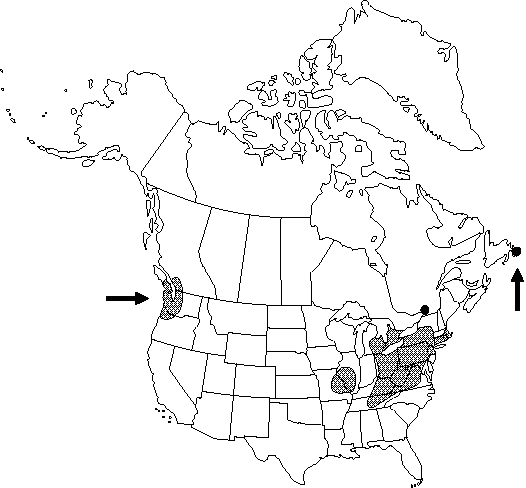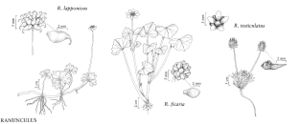Difference between revisions of "Ranunculus ficaria"
Sp. Pl. 1: 550. 1753.
FNA>Volume Importer |
imported>Volume Importer |
||
| (One intermediate revision by the same user not shown) | |||
| Line 42: | Line 42: | ||
|habitat=Shaded stream banks and moist disturbed areas | |habitat=Shaded stream banks and moist disturbed areas | ||
|elevation=0-300 m | |elevation=0-300 m | ||
| − | |distribution=B.C.;Nfld.;Ont.;Que.;Conn.;D.C.;Ill.;Ky.;Md.;Mass.;Mich.;Mo.;N.J.;N.Y.;Ohio;Oreg.;Pa.;R.I.;Tenn.;Va.;Wash.;W.Va.;native to Europe. | + | |distribution=B.C.;Nfld. and Labr. (Nfld.);Ont.;Que.;Conn.;D.C.;Ill.;Ky.;Md.;Mass.;Mich.;Mo.;N.J.;N.Y.;Ohio;Oreg.;Pa.;R.I.;Tenn.;Va.;Wash.;W.Va.;native to Europe. |
| + | |introduced=true | ||
|discussion=<p>In North America, <i>Ranunculus ficaria</i> seems to be expanding its range rapidly in areas with cool mesic climates.</p><!-- | |discussion=<p>In North America, <i>Ranunculus ficaria</i> seems to be expanding its range rapidly in areas with cool mesic climates.</p><!-- | ||
--><p>The species is extremely variable (especially in leaf size and stem posture), and many attempts have been made to divide it into varieties or subspecies (see P. D. Sell 1994). The different forms, however, intergrade extensively and the varieties are often impossible to distinguish.</p> | --><p>The species is extremely variable (especially in leaf size and stem posture), and many attempts have been made to divide it into varieties or subspecies (see P. D. Sell 1994). The different forms, however, intergrade extensively and the varieties are often impossible to distinguish.</p> | ||
| Line 62: | Line 63: | ||
|habitat=Shaded stream banks and moist disturbed areas | |habitat=Shaded stream banks and moist disturbed areas | ||
|elevation=0-300 m | |elevation=0-300 m | ||
| − | |distribution=B.C.;Nfld.;Ont.;Que.;Conn.;D.C.;Ill.;Ky.;Md.;Mass.;Mich.;Mo.;N.J.;N.Y.;Ohio;Oreg.;Pa.;R.I.;Tenn.;Va.;Wash.;W.Va.;native to Europe. | + | |distribution=B.C.;Nfld. and Labr. (Nfld.);Ont.;Que.;Conn.;D.C.;Ill.;Ky.;Md.;Mass.;Mich.;Mo.;N.J.;N.Y.;Ohio;Oreg.;Pa.;R.I.;Tenn.;Va.;Wash.;W.Va.;native to Europe. |
|introduced=true | |introduced=true | ||
|reference=None | |reference=None | ||
| Line 68: | Line 69: | ||
|publication year=1753 | |publication year=1753 | ||
|special status=Illustrated;Introduced | |special status=Illustrated;Introduced | ||
| − | |source xml=https:// | + | |source xml=https://bitbucket.org/aafc-mbb/fna-data-curation/src/2e0870ddd59836b60bcf96646a41e87ea5a5943a/coarse_grained_fna_xml/V3/V3_896.xml |
|genus=Ranunculus | |genus=Ranunculus | ||
|subgenus=Ranunculus subg. Ficaria | |subgenus=Ranunculus subg. Ficaria | ||
Latest revision as of 22:52, 5 November 2020
Stems erect to decumbent, not rooting nodally, glabrous, not bulbous-based, spheric or ellipsoid bulbils sometimes formed in leaf axils. Tuberous roots present. Basal leaves simple and undivided, blades cordate to deltate or semicircular, 1.8-3.7 × 2-4 cm, base cordate, margins entire or crenate, apex rounded or obtuse. Flowers: receptacle glabrous; sepals spreading, saccate at extreme base, 4-9 × 3-6 mm, glabrous; petals yellow, 10-15 × 3-7 mm. Heads of achenes hemispheric, 4-5 × 6-8 mm; achenes 2.6-2.8 × 1.8-2 mm, pubescent; beak absent.
Phenology: Flowering spring (Apr–May).
Habitat: Shaded stream banks and moist disturbed areas
Elevation: 0-300 m
Distribution

Introduced; B.C., Nfld. and Labr. (Nfld.), Ont., Que., Conn., D.C., Ill., Ky., Md., Mass., Mich., Mo., N.J., N.Y., Ohio, Oreg., Pa., R.I., Tenn., Va., Wash., W.Va., native to Europe.
Discussion
In North America, Ranunculus ficaria seems to be expanding its range rapidly in areas with cool mesic climates.
The species is extremely variable (especially in leaf size and stem posture), and many attempts have been made to divide it into varieties or subspecies (see P. D. Sell 1994). The different forms, however, intergrade extensively and the varieties are often impossible to distinguish.
Selected References
None.
